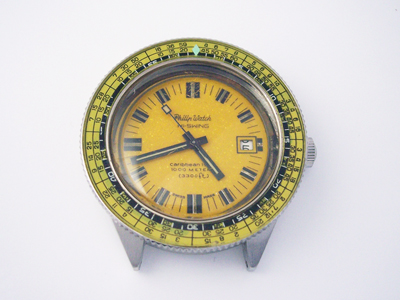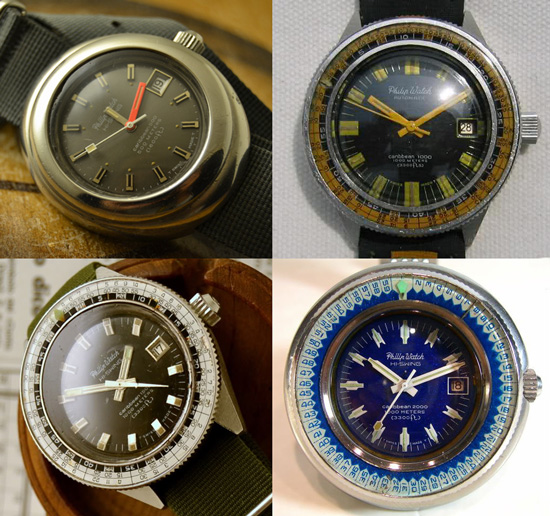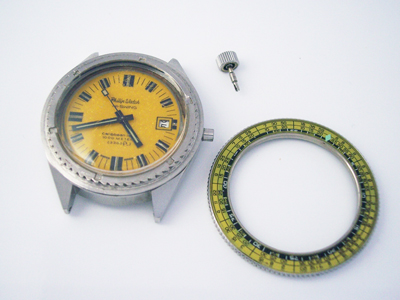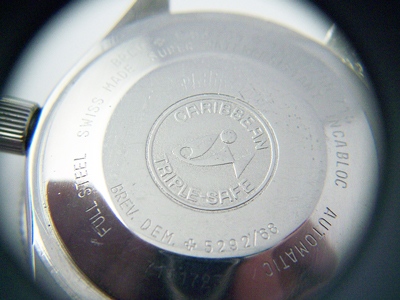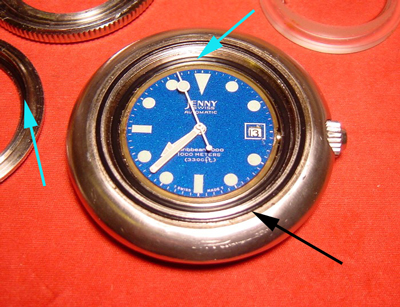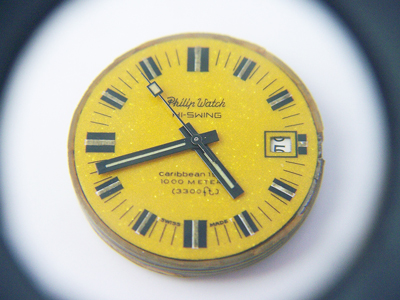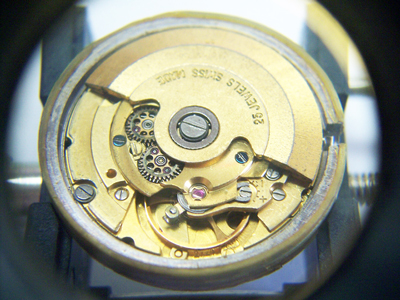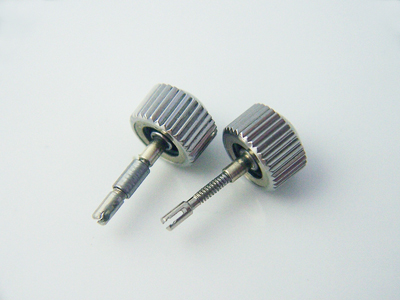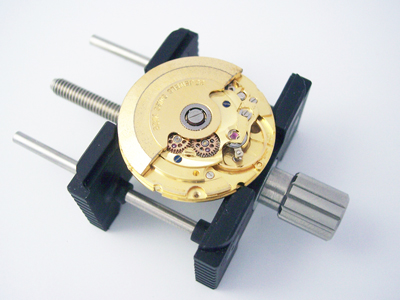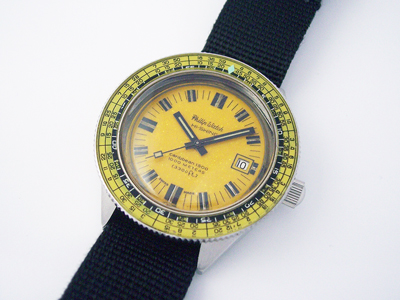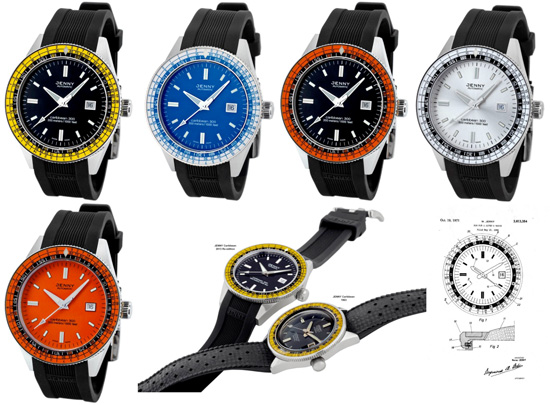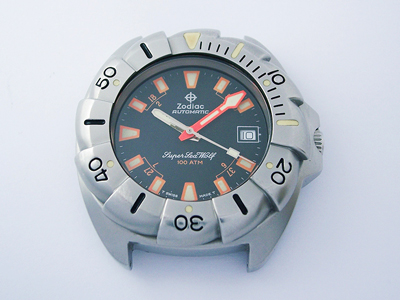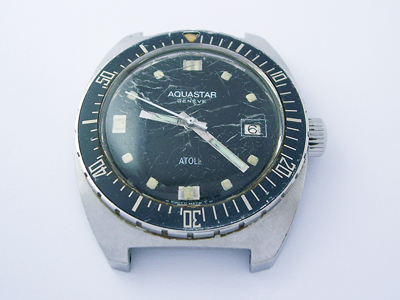It may be winter but this yellow dialled Philip Watch Caribbean 1500 reminds me of warm seas and sandy beaches.
(Click pictures to enlarge)
The Philip Watch company have a history dating all the way back to 1858. They were founded in Naples by François Philippe, a Swiss expatriate who worked with numerous members of the Swiss community to create watches using the skills they had learned in the Jura mountains. The trademark “Philippe Watch” was first registered with the Naples office in 1923 and the company followed the path taken by many watch companies, specialising first in pocket watches and subsequently producing wristwatches.
I’m sure it won’t have escaped your notice that the “Philippe” name is very similar to another famous Swiss watch brand with an equally long history, though the two companies are not connected. In order to avoid any confusion, an agreement was made with Patek Philippe in 1947, and the company name was changed from “Philippe Watch” to “Philip Watch”.
Philip Watch are still trading today and they are now based in Milan. They produce mainly quartz watches these days (including a Caribbean diver), though they do have a small number of automatic models in their line up. You can see the current range on their website here.
The watch in this blog dates to the late 1960’s or early 1970’s when Philip had a number of models in their Caribbean range; the 500, 1000, 1500 and 2000, all available in a variety of dial designs/colours.
The watch is housed in a one-piece case (yes, another one!), so the outer bezel has to be levered off and the split stem/crown unscrewed and separated to allow access to a crystal retaining ring which is screwed into the case. Once this ring has been removed, the crystal can be lifted out and the watch removed from the case.
The name ‘Caribbean’ comes from the construction of the case which was developed and patented by a company called Jenny in 1963. Similar to Squale who I wrote about a few months ago (here if you missed it), Jenny was another company who produced high quality watch cases and sold them under licence to other manufacturers. Consequently, in addition to Philip and Jenny themselves, you’ll see the Caribbean case used by Aquadive, Ollech & Wajs (O&W), Eisenhardt, Jaquet Droz, Perona and Fortis to name but a few.
On the back of all 1000m Caribbean cases is the name, the Jenny ‘fish’ logo and also the words ‘Triple-Safe’.
In order to survive at such great depths, the watch has an extra thick acrylic crystal and three case gaskets – hence the ‘Triple-Safe’ branding. The gaskets can be seen on this disassembled Jenny case.
The large step on the watch crystal is effectively sandwiched between two gaskets, one around the movement in the case and one on the inside of the crystal securing ring (highlighted by the blue arrows). The case also has additional gasket on the upper edge, i.e. under the outer edge of the securing ring. All Caribbean cases are fitted with a screwdown crown for extra security.
With the watch out of the case it’s worth having a closer look at the dial. You could be forgiven for thinking that it is covered in dust, but on closer inspection you can see that the dial paint has reflective elements in it – an effect I’m going to call ‘yellow crackle’. Very nice!
The movement inside this watch is an ETA cal. 2724, a 25 jewel automatic which was made between 1969-1972 – a significant calibre for ETA as it was their first with a beat rate of 28,800 bph. Although several other manufacturers were already producing calibers with beat rates of 36,000 bph, at that time 28,800 bph was still considered ‘high beat’, so the dial on this watch has ‘Hi-Swing’ printed on it to recognise the fact.
Aside from needing a service, the watch arrived with a few other minor issues; the date changeover wasn’t working correctly, it wouldn’t wind manually, and it had problems with the action of the crown.
On closer inspection it was found that the crown was damaged and needed to be replaced, and that the stem was a fraction too short. You can see in the picture below that the original stem assembly on the left has a stem extender fitted (the box section in the middle of the stem). The stem, crown and case tube were all replaced to put things right.
The movement was looking much better after a service with just a hint of wear on the winding rotor due to the watch not being properly secured in the case. You can see in the movement picture above that the spacer is encased in a ring of what Jenny called ‘Pneulastic’ – a kind of soft plastic which acts as a shock absorber. However, as is often the case with aged plastic, it has a tendency to shrink and so the watch becomes loose inside the case. A simple shim was all that was needed during reassembly to secure it.
With no cosmetic work to do on this one, all that remained was to clean the case and rebuild.
Anyone attracted to this kind of watch may be interested to know that Jenny was relaunched in 2012 and is now producing a re-edition of one their vintage models. Although the watch doesn’t have a true Caribbean case (the company opting for a regular screwed caseback instead), it is certainly reminiscent of the original, and is available in five different designs – sadly no yellow crackle!
More information can be found on their website : http://www.jennywatches.com/
Rich
** Many thanks to Ed Boyce for letting me feature his watch on the blog. **

